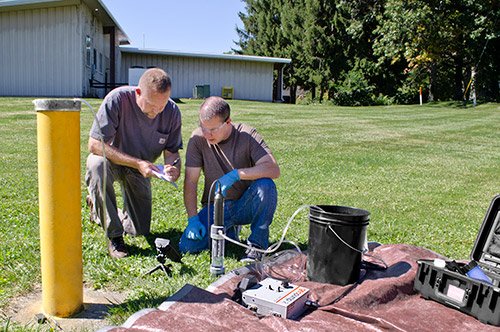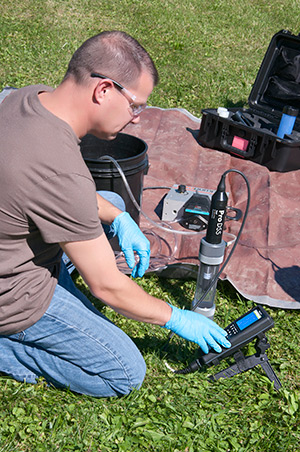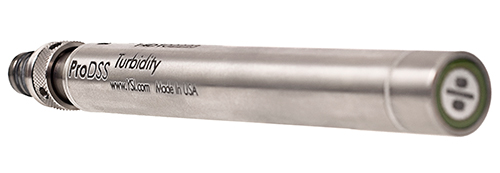Groundwater Contaminant Plume Delineation and Bioremediation Monitoring
Based in Portland, Oregon, Hahn and Associates, Inc., (HAI), provides environmental consulting services related to contamination of soil and groundwater in the Pacific Northwest. They specialize in problem-solving for the municipal, commercial and industrial communities, and their clients have included individuals, businesses, lenders, developers, land conservation groups, utilities, and public agencies. HAI has conducted over 4,000 Phase I Environmental Site Assessments (ESA) since 1987. Their experienced team of environmental professionals has assessed every type of property, ranging from residential properties to large tracts of undeveloped land, to commercial and industrial properties.
Much of the work that HAI has done over the years is long-term low-flow groundwater sampling projects. When completing these projects, HAI uses the YSI ProDSS with flow cell to measure several physical and chemical parameters of the water coming out of the well. Once these measurements reach a certain stability criteria, HAI has confidence they are collecting formation water for further analysis at a lab.
With such an active workload, and with many clients and agencies relying on the data they provide, HAI leans heavily on their instrumentation – both in the lab and in the field. At the end of the day, field instruments need to be accurate, dependable, and consistent. Ruggedness is also critical, as instruments must meet the demands of field sampling.

Data You Can Trust
 In the fall of 2014, to hopefully address some of the challenges they were having with existing water quality field meters, HAI acquired a YSI ProDSS multiparameter handheld water quality meter. With four sensor ports and the ability to measure up to 20 different parameters, HAI was very interested to see how the meter performed and how it might impact the daily routines of their field staff. What they got was a ruggedized, easy-to-use field instrument that worked reliably for them at job site after job site.
In the fall of 2014, to hopefully address some of the challenges they were having with existing water quality field meters, HAI acquired a YSI ProDSS multiparameter handheld water quality meter. With four sensor ports and the ability to measure up to 20 different parameters, HAI was very interested to see how the meter performed and how it might impact the daily routines of their field staff. What they got was a ruggedized, easy-to-use field instrument that worked reliably for them at job site after job site.
“We mainly use the new meter on low-flow groundwater monitoring projects,” says Ben Uhl, R.G., Field Manager for HAI. “During the groundwater purging process of the wells, we can identify when they have reached ‘stable’ conditions, upon which a groundwater sample can be collected. Our stabilization criteria is important to meet and it is essential to have a meter that can provide accurate and precise readings of these measurements. When looking at trend plots of field measurements over time, reliable data is a must, and the ProDSS is able to provide data we can trust. That’s a huge benefit for us.”
“When looking at trend plots of field measurements over time, reliable data is a must, and the ProDSS is able to provide data we can trust. That’s a huge benefit for us.”
Case Study #1: Copper Sulfate Contamination
Along with the slew of ongoing, long-term monitoring projects that HAI has been involved with, they are also engaged in specific projects where they investigate for possible contamination of groundwater or soil. One such project involved a manufacturing facility that had potentially released copper sulfate. The facility manufactured circuit boards for use in numerous applications, from automotive and flight control systems to telecom switching and renewable energy. HAI was brought in to install wells for groundwater sample collection and provide data to the client.
“The data captured by the ProDSS, monitoring pH and ORP in temporary groundwater wells, helped us to determine and delineate the presence and magnitude of the release,” says Uhl. “This saved the client from installing additional wells for investigation and groundwater sample collection, thereby reducing costs related to equipment, field staff, and laboratory testing, and that turned out to be a big deal for them.”
Case Study #2: Chlorinated Solvent Bioremediation
Another specific application was a site where chlorinated solvents from a former dry cleaning operation had contaminated groundwater. Under the Voluntary Cleanup Program through the Oregon Department of Environmental Quality (DEQ), HAI installed a bioremediation system in which a carbon substrate was injected into recirculating groundwater (extraction and injection wells). Field readings, taken weekly by the ProDSS from the wells, allowed HAI to monitor system performance. Identifying groundwater wells with a high positive ORP indicated the carbon substrate had not yet reached a particular location of the site, while a very negative ORP or low DO (dissolved oxygen) levels indicated that the carbon substrate was having an effect (anaerobic - reducing environment) and bioremediation of the chlorinated solvents was occurring.
“This project required highly accurate field readings, which we were able to get from the ProDSS,” Uhl continues. “To confirm the accuracy of the data with the DEQ, we were able to directly correlate the weekly field measurements with lab data and trends over time, confirming chlorinated solvent biodegradation. The field measurements provide us with ‘real-time’ insight of the bioremediation system performance. This saves us money so we don’t have to collect samples constantly for laboratory testing, which in turn reduces project costs related to field staff and additional equipment usage. It’s a win-win for HAI and for the customer.”
Game Changer
In addition to saving time and money with field water quality instrumentation like the ProDSS, the HAI team has also found that features like simple calibration, color display, and long life of the rechargeable battery can provide game-changing benefits when looking at the different types of handheld meters available on the market. The ProDSS turbidity sensor is also convenient, as HAI previously had to prepare samples in order to measure turbidity with a colorimeter. The GPS coordinates that are automatically captured with each reading – tying the readings back to a specific location – is a key user-friendly feature as well.

Given their rich history and involvement with such a broad scope of environmental consulting projects, HAI has a lot of experience with water quality field meters. With the ProDSS, HAI has found they can easily and efficiently measure the parameters they need, all on one instrument.

Additional Blog Posts of Interest
Free ProDSS Online Training | Everything You Need to Know
Comparing the YSI ProDSS vs EXO Water Quality Meters
What is the Best Handheld Water Quality Meter? | YSI ProDSS Digital Sampling System
Advanced Groundwater Monitoring At National Corvette Museum Sinkhole